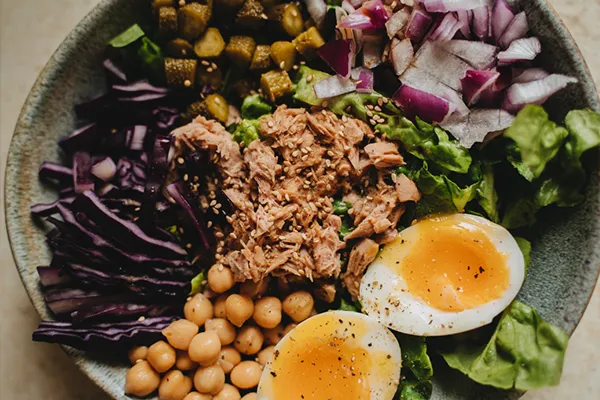
10 Practical Tips to Easily Get 100+ Grams of Protein Daily
Protein is essential for building and maintaining muscle, supporting your metabolism, and helping you feel full after meals. While the standard recommendation is at least 0.8 grams per kilogram of body weight, many experts suggest aiming higher—especially during weight loss, aging, or periods of increased activity.
Getting 100+ grams of protein per day may seem tough, but with a few smart habits, it becomes much more achievable. Here are ten practical ways to reach your protein goals.

1. Add Protein to Your Morning Coffee
You can boost your protein intake with almost no extra effort by adding a scoop of collagen peptides (about 10–18g protein) to your morning coffee. Collagen dissolves easily, doesn’t change the taste, and is an easy way to start the day with extra protein.
2. Keep Protein Shakes Ready
Convenient, ready-to-drink protein shakes can help you hit your protein target, especially when you’re busy. Look for shakes with 20–30g of protein per serving. You can also add them to coffee or use them as a snack on the go.

3. Upgrade Your Breakfast
Choose high-protein breakfast options:
Greek yogurt (15–20g per cup)
Protein pancakes or overnight oats with added protein powder (20–30g per serving)
Cottage cheese (24g per cup)
Simple swaps can help you start the day strong.
4. Increase Protein Portions in Meals
If you usually have a small serving of protein at lunch or dinner, try increasing it by 50–100%. For example, use 5–6 ounces of chicken or fish instead of 3 ounces. Cooking extra protein at dinner also makes meal prep for the next day easier.

5. Use Greek Yogurt in Multiple Ways
Greek yogurt isn’t just for breakfast. Try using it as a base for creamy salad dressings, flavorful dips, or blending it into smoothies for extra protein and a smooth texture. Its high protein content makes it a smart addition to meals and snacks, and it works well in both savory and sweet recipes, from marinades to desserts.
6. Snack on Protein-Rich Foods
Healthy snacks with protein keep you satisfied and help bridge the gap between meals:
Hard-boiled eggs (6g each)
Jerky (about 10–13g per ounce)
Edamame (17g per cup)
Protein bars (aim for 15–20g and low sugar)
Cottage cheese or string cheese
7. Power Up Your Smoothies
Build smoothies with protein in mind:
Add a scoop of protein powder (20–25g)
Use Greek yogurt (15–20g per cup)
Add chia seeds (3g per tablespoon) and milk (8g per cup if dairy)
This turns a simple smoothie into a complete meal or snack.
8. Pick Higher-Protein Plant Foods
For plant-based or flexitarian diets, choose:
Edamame or chickpea pasta (up to 25g per serving)
Quinoa (8g per cup)
Tofu or tempeh (15–20g per 3oz)
Lentils and beans (7–9g per half-cup)
Mixing different plant proteins throughout the day helps provide all essential amino acids.

9. Add Protein Powder to Everyday Foods
Protein powder can boost the protein content of many foods:
Stir into oatmeal, pancake mix, or yogurt
Blend into sauces, soups, or baked goods
Use unflavored or mild-tasting protein powders for best results
10. Enjoy Protein-Rich Desserts
Satisfy your sweet tooth with options like:
Greek yogurt parfaits with fruit (15g protein)
Protein mug cakes (15–20g)
Protein puddings or hot chocolate made with protein powder (20–25g)
Cottage cheese with fruit and cinnamon (14g per half-cup)
Special Considerations
If you use GLP-1 medications: Appetite may be reduced, so focus on protein-dense foods first in your meals. Shakes or soft proteins can help if solid foods are difficult.
Plant-based eaters: Combine different plant proteins (like beans and grains) to get a full range of amino acids. Pea protein and soy protein are especially high-quality.
Active individuals: Try to have 20–30g of protein within an hour after exercise to support muscle recovery.

Example: How to Get 100+ Grams of Protein in a Day
Breakfast:
Coffee with collagen (10g)
Greek yogurt and berries (20g)
Snack:
Protein shake (30g)
Lunch:
Salad with chicken breast (28g)
Snack:
Hard-boiled egg (6g)
String cheese (7g)
Dinner:
Salmon fillet (29g)
Quinoa and vegetables (6g)
Dessert:
Cottage cheese with fruit (14g)
Daily total: ~150g protein
Start by adding 1–2 protein-focused habits each week.
Mix and match tips to find what fits your routine and preferences.
Remember, consistency matters most—aim for steady protein intake each day.
Getting enough protein is achievable and can help support your muscle health, metabolism, and overall well-being.
Ready to feel your best? Start your weight loss journey with Valor Wellness today. Get weight loss medication delivered directly to your door with our Online Pharmacy, or Schedule An Appointment at one of our wellness clinics today.

